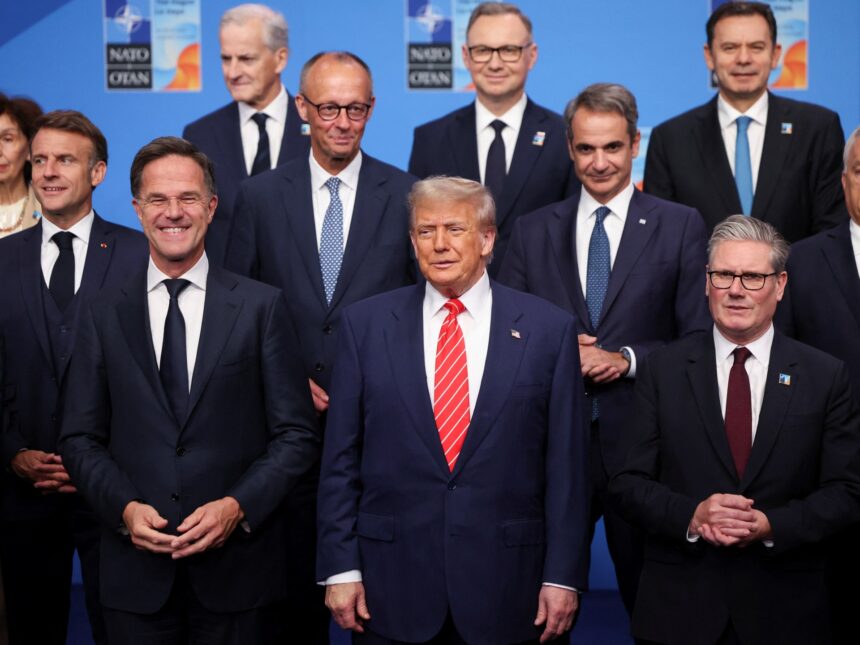In a climate of heightened geopolitical tensions, NATO’s recent push for members to commit a minimum of 5% of GDP to defense spending has ignited fierce debate across alliance capitals, with citizens and policymakers alike questioning the balance between military readiness and social investments.
The stark contrast between defense allocations and spending on healthcare and education has emerged as a flashpoint, particularly as many NATO countries still struggle with post-pandemic economic recovery. According to figures released yesterday by the alliance, only eight of the 32 member states currently meet the existing 2% GDP threshold for defense spending, with the proposed increase representing a seismic shift in national budgeting priorities.
“We’re asking nations to make difficult but necessary choices,” said NATO Secretary General Mark Rutte during yesterday’s press conference in Brussels. “The security landscape has fundamentally changed, and our funding models must evolve accordingly.”
Analysis of public spending data reveals the potential trade-offs involved. In Canada, where defense spending currently hovers around 1.38% of GDP, a jump to 5% would require an additional $76 billion annually—equivalent to nearly two-thirds of the country’s entire healthcare budget. Similar proportions apply across most alliance members, with countries like Germany, Spain, and Italy facing particularly challenging reallocations.
The United States, which already spends 3.5% of its GDP on defense, would need to find an additional $320 billion annually to meet the proposed threshold—roughly equivalent to its federal education budget.
Dr. Helena Forsyth, economic policy expert at the University of Toronto, told CO24 that such a dramatic shift could have profound implications. “We’re talking about potentially redirecting funds from critical social infrastructure at a time when many countries are still addressing pandemic-related educational deficits and healthcare backlogs,” she said.
The proposal has drawn sharp criticism from progressive lawmakers across Europe and North America. In a joint statement released this morning, a coalition of opposition parties from 12 NATO countries characterized the 5% target as “fundamentally incompatible with maintaining robust social safety nets.”
Defense analysts counter that the investment is essential given Russia’s ongoing aggression in Ukraine and growing concerns about China’s military expansion. General Michael Barone, former NATO military committee chairman, emphasized that “security underpins all other national priorities” during his address at yesterday’s Atlantic Council forum.
The proposal comes amid troubling new intelligence assessments suggesting that Russia has accelerated its defense manufacturing capabilities despite Western sanctions. According to classified briefings shared with alliance members last week, Moscow has nearly doubled production of key weapons systems compared to pre-invasion levels.
The spending debate has particularly resonated in smaller NATO members like Lithuania, Latvia, and Estonia, which already dedicate significant portions of their budgets to defense due to their proximity to Russia. Estonian Defense Minister Hanno Pevkur remarked during last week’s Tallinn Security Conference that “for Baltic nations, this isn’t academic—it’s existential.”
Public opinion across alliance countries remains deeply divided. A recent multinational survey conducted by the European Council on Foreign Relations found that while 68% of respondents support strengthening NATO’s defensive capabilities, only 37% would accept significant reductions in social spending to achieve this goal.
The most creative solutions may come from nations like Denmark and Norway, which are exploring dedicated defense investment funds separate from annual budgets, potentially allowing them to meet security commitments without immediate cuts to social programs. This approach has gained traction among finance ministers seeking to balance competing priorities.
As NATO leaders prepare for their crucial summit next month in Washington, the fundamental question remains unresolved: in an increasingly unstable world, how do democratic societies balance the immediate needs of citizens with long-term security imperatives without sacrificing either? The answer may reshape Western budgetary priorities for decades to come.










